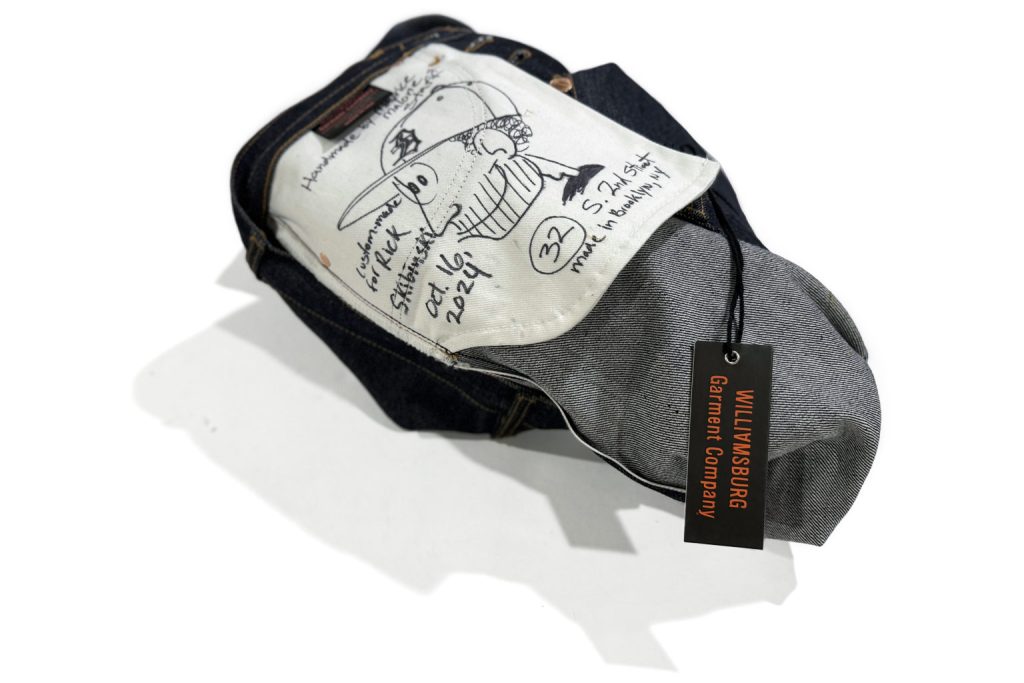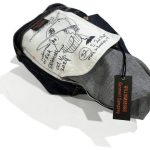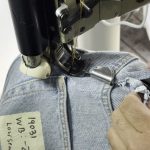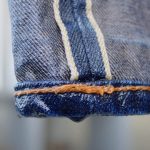You may have tried learning through YouTube or social media videos—but when you’re serious about mastering a craft, you quickly realize that online content can only take you so far.
Read More →
If you’ve ever typed how to take in the waist of jeans into Google, you’ve probably seen a lot of DIY tricks—some good, some pretty questionable. But here’s the thing: there’s a world of difference between a quick fix at home and a professional alteration that looks like it came straight from the factory.
At Denim BMC, we know our readers care about denim done right. That’s why we’re sharing a look inside Williamsburg Garment Company’s proven method for taking in the waist on jeans—without darts, shortcuts, or messy seams.
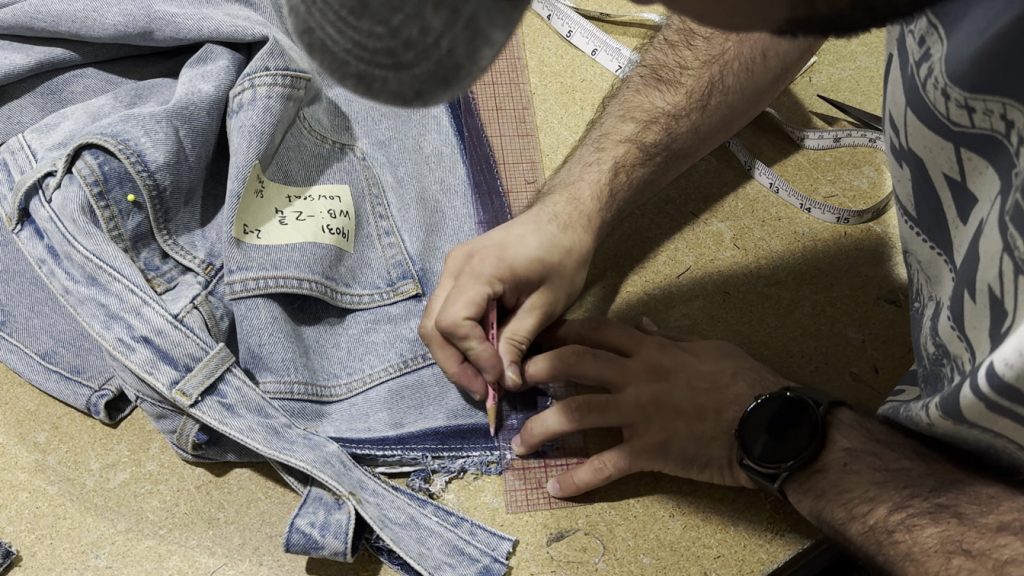
In this video, owner Maurice Malone walks you through the same technique he developed back in the twenty-teens, when a customer asked him to take in his jeans without leaving any sign of an alteration. Most tailors rely on darts because they don’t have the right industrial machines to handle heavy denim, chainstitch seat seams, and belt loop reattachments. Maurice shows how real pros do it: four specialized machines, careful disassembly, and a factory-finish result that holds up to close inspection.
If you’re serious about your denim, it’s worth seeing how proper waist alterations are done—and why they matter so much if you want your jeans to fit perfectly and still look original.
Watch the video below to see the full process in action and learn why Williamsburg Garment Company is trusted by denim lovers nationwide.
You might be interested in
Most people simply don’t realize that tailoring jeans or knitwear is a specialized service. It’s not something every tailor does
You may have tried learning through YouTube or social media videos—but when you’re serious about mastering a craft, you quickly
The first brand in our new lineup was TCB Jeans, a company out of Kojima, Japan that builds its reputation
The leg opening measurement is a critical factor in how your jeans fit over your shoes and shape your overall

The leg opening measurement is a critical factor in how your jeans fit over your shoes and shape your overall look. Whether you’re shopping online, comparing styles, or getting your jeans tapered, knowing how to measure the leg opening properly ensures accurate sizing and a better fit.
In this guide, we’ll break down the correct method for measuring the leg opening on jeans—just like we do in our professional denim alteration shop at Williamsburg Garment Company.
📏 What Is the Leg Opening on Jeans?
The leg opening is the width of the bottom hem of a pant leg. This measurement determines how fitted or wide the jeans will fall over your shoes. Slim, straight, bootcut, and wide-leg jeans all have different leg opening sizes, which impact the overall silhouette of the jeans.
🔥 Why Does It Matter?
✅ Helps compare different fits when buying jeans online
✅ Essential for tapering alterations to ensure a balanced look
✅ Impacts how jeans sit on top of shoes
🛠 Step-by-Step: How to Measure the Leg Opening on Jeans
Follow these simple steps to accurately measure the leg opening of your jeans.
1️⃣ Lay the Jeans Flat
- Place your jeans on a flat surface, like a table or the floor.
- Smooth out any wrinkles, but do not stretch the fabric.
🔽 See the diagram below for proper positioning:
[Insert drawing: Jeans laid flat with a focus on the hem area]
2️⃣ Align the Hem Evenly
- Make sure both layers of fabric at the bottom hem are lined up evenly.
- Some jeans, especially washed or worn pairs, may have twisting in the leg—try to align them as close to their natural shape as possible.
🔽 Illustration showing the hem properly aligned:
[Insert drawing: Close-up of the bottom hem, ensuring both sides are even]
3️⃣ Measure Across the Bottom Hem
- Use a soft measuring tape and place it edge to edge across the leg opening.
- Do not curve or wrap the tape—measure in a straight line.
- Write down this measurement.
🔽 Example of correct measuring technique:
[Insert drawing: Measuring tape laid straight across the hem from one edge to the other]
4️⃣ Double the Measurement
- Since jeans are measured flat, you’ll need to double the number to get the full leg opening circumference.
- Example: If your measurement is 8 inches, the total leg opening is 16 inches.
🚨 Common Mistakes to Avoid
🔴 Not laying the jeans completely flat – Wrinkles and folds can throw off your measurement.
🔴 Measuring diagonally – Always measure straight across for accuracy.
🔴 Ignoring leg twisting – Some jeans may have a twist in the leg seam due to shrinkage or wash effects. Align them properly before measuring.
👖 How the Leg Opening Affects Fit
The leg opening measurement is key to understanding different jean styles:
- Slim Fit Jeans – Narrow leg opening (usually 12″–14″)
- Straight Fit Jeans – More room at the ankle (14″–16″)
- Bootcut Jeans – Slight flare to fit over boots (16″–18″)
- Wide-Leg Jeans – Loose fit with a larger leg opening (18″+)
📢 Thinking about tapering your jeans? If you want a smaller leg opening, professional tapering is the best way to achieve a clean, proportional fit. Check out our denim tapering service for expert alterations.
🎥 Watch the Video: Measuring the Leg Opening
For a full demonstration, watch our step-by-step video on how to measure the leg opening on jeans featuring Maurice Malone of Williamsburg Garment Company.
📌 Subscribe for more denim fit and alteration guides!
This blog post is now optimized for readability, SEO, and usability with step-by-step instructions and custom drawings to assist readers. I’ll generate the requested illustrations now. Stay tuned! 🎨📏
You might be interested in
You may have tried learning through YouTube or social media videos—but when you’re serious about mastering a craft, you quickly
If you’ve ever typed how to take in the waist of jeans into Google, you’ve probably seen a lot of
The first brand in our new lineup was TCB Jeans, a company out of Kojima, Japan that builds its reputation
Washing raw denim has long been a topic of debate. Some purists believe in waiting as long as possible, while

Washing raw denim has long been a topic of debate. Some purists believe in waiting as long as possible, while others argue that washing enhances the fabric’s character. But knowing how to wash raw denim jeans properly can make all the difference in maintaining the integrity of the denim while preserving those hard-earned fades.
In their latest video, Benzak Denim Developers demonstrate their recommended method for washing raw denim for the first time, using a well-worn pair of BO2 Straight jeans made from their 10-year anniversary denim. They cover everything from prepping your jeans before the wash to selecting the right machine settings—ensuring your denim stays in top shape without unnecessary shrinkage or fading.
If you’ve ever wondered when to wash, why washing matters, or most importantly, how to wash raw denim jeans, this video lays it all out. Watch below to see how a year of wear transforms after a proper wash.
You might be interested in
You may have tried learning through YouTube or social media videos—but when you’re serious about mastering a craft, you quickly
If you’ve ever typed how to take in the waist of jeans into Google, you’ve probably seen a lot of
The first brand in our new lineup was TCB Jeans, a company out of Kojima, Japan that builds its reputation
The leg opening measurement is a critical factor in how your jeans fit over your shoes and shape your overall
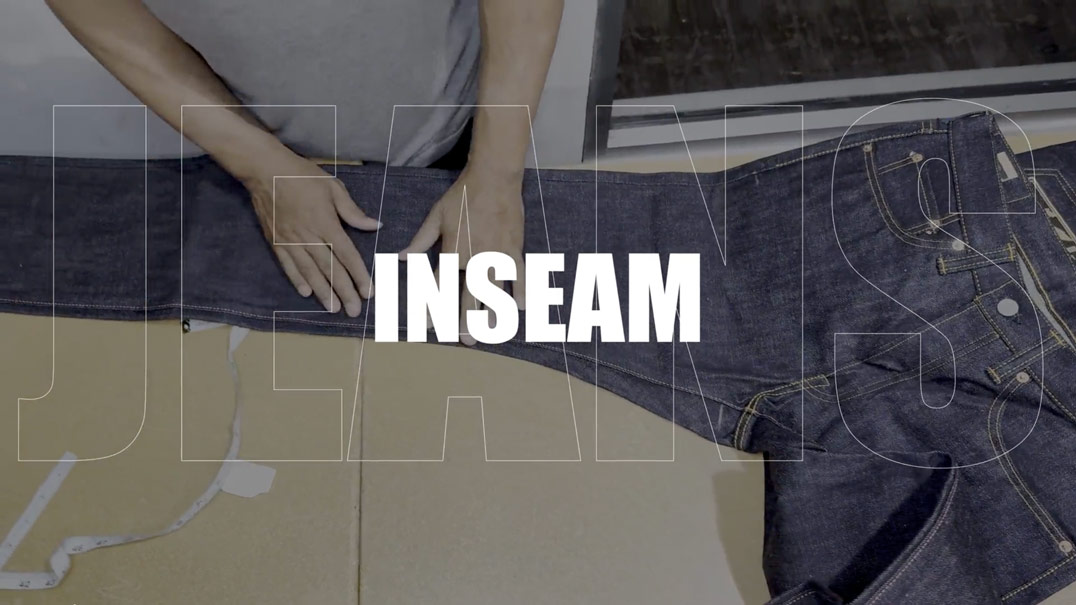
When it comes to buying jeans—especially online—getting the right inseam measurement is crucial for a proper fit. Whether you’re checking your size before ordering, comparing different brands, or preparing for hemming, measuring the inseam correctly ensures you won’t end up with jeans that are too short or too long.
In this guide, we’ll break down how to measure the inseam on jeans the right way, just like the professionals. Plus, watch our quick video tutorial featuring Williamsburg Garment Company’s own Maurice Malone, who walks you through the process step by step.
📏 What Is the Inseam on Jeans?
The inseam is the measurement from the crotch seam (where the inner thigh seams meet) down to the hem of the pant leg. It determines the length of your jeans and is one of the most important sizing details when shopping for denim.
🛠 Step-by-Step: How to Measure the Inseam on Jeans
Follow these steps to measure your inseam accurately:
1️⃣ Lay the Jeans Flat
- Find a flat surface (like a table or the floor) to lay your jeans down.
- Smooth out any wrinkles, but don’t stretch the fabric.
2️⃣ Start at the Center of the Crotch Seam
- Place your measuring tape at the center of the crotch seam, between the two stitch lines of the flat-felled seam.
- This is the center point of the flat-felled seams, which ensures an accurate starting position.
3️⃣ Follow the Natural Shape of the Leg
- Extend the measuring tape down the inside of the leg, following the natural curve.
- Avoid pulling the tape too tight or leaving slack—precision matters!
4️⃣ Measure to the Hem
- Stop at the bottom edge of the hem and take note of the number.
- This final measurement is your inseam length.
🚨 Common Mistakes to Avoid
🔴 Measuring in a straight line – The inseam follows the natural curve of the leg, so don’t measure at an angle or cut across the fabric.
🔴 Starting at the wrong point – Always measure from the center of the crotch seam, between the stitch lines, not from the seam line or a random point along the leg.
🔴 Ignoring fabric twist – Some jeans, especially washed or vintage styles, may have a slight twist. Follow the intended seam line, not any twisting caused by wear.
👖 Why Accurate Inseam Measurements Matter
If your jeans are too long or too short, it affects both comfort and style. Knowing your inseam helps when:
✅ Buying jeans online – Compare with the brand’s size chart to get the right fit.
✅ Altering your jeans – Get the perfect length when hemming.
✅ Finding the right cut – Different inseams work better for different styles (stacking, cuffing, or a clean break at the shoe).
⚠️ Don’t Assume the Inseam Length on the Tag Is Accurate
When you purchase a pair of jeans, it is highly likely that the inseam length on the tag is not correct. Most brands intentionally make their inseams longer than the labeled length, figuring it’s better to be longer than shorter or to allow for shrinkage after washing or alterations if needed. However, in some cases, brands may even produce inseams that are shorter than labeled—so always measure your jeans instead of trusting the tag.
⚠️ Be Careful When Ordering Hemming on Multiple Jeans
If you’re getting multiple pairs of jeans hemmed, avoid ordering the same inseam length across different styles without considering fit type and rise length.
- Rise differences matter – Even if two jeans have the same waist measurement, a longer rise will result in an inseam that appears longer. Since both jeans sit at the same position on your body due to the identical waist measurement, the additional rise length means the hem will fall lower on your leg.
- Waist opening affects inseam fit – The waist opening measurement generally determines where jeans sit on your body. For example, a larger waist measurement will sit lower on the hips compared to a smaller waist, even if the rise is the same. This lower placement causes the inseam to effectively be longer, as the jeans rest further down on your body.
These factors mean that jeans of the same labeled inseam can fit very differently based on their waist and rise measurements. To ensure consistency, always measure each pair individually before choosing a hemming length.
📌 Need Professional Denim Alterations?
At Williamsburg Garment Company, we specialize in professional denim hemming and alterations, ensuring your jeans fit perfectly—no matter the inseam length.
You might be interested in
You may have tried learning through YouTube or social media videos—but when you’re serious about mastering a craft, you quickly
If you’ve ever typed how to take in the waist of jeans into Google, you’ve probably seen a lot of
The first brand in our new lineup was TCB Jeans, a company out of Kojima, Japan that builds its reputation
The leg opening measurement is a critical factor in how your jeans fit over your shoes and shape your overall
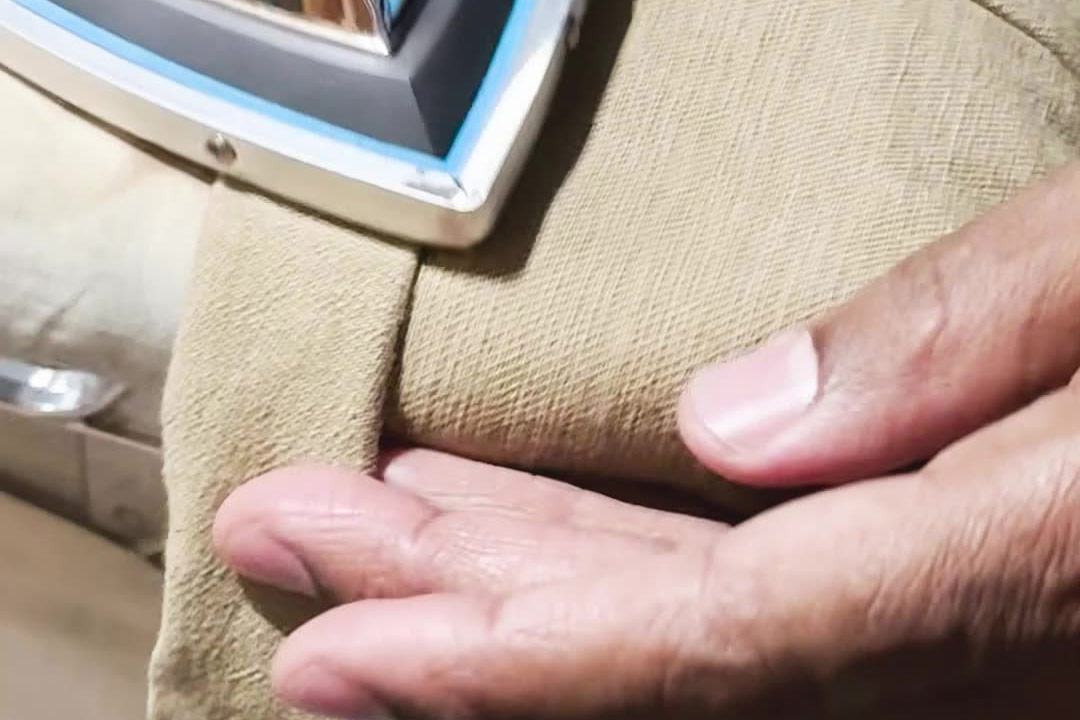
When it comes to hemming pants, maintaining the original look is key. Many tailors use what’s known as an “original hem alteration,” where they cut off the hem and reattach it with an added seam. But let’s be honest—that’s a poor man’s alteration technique. It compromises quality, especially for pants that aren’t distressed jeans. Following the manufacturer’s original stitching and details is the only way to ensure a professional result. Anything less can cost you discerning customers once they notice the poor craftsmanship inside their pants.
In this tutorial, I’ll show you how to hem pants professionally. If you have an industrial sewing machine, you’ll be able to follow along—just make sure you have the correct thread and needle sizes. These details matter, and most tailors overlook them.
If you’re using a home machine, the techniques I cover can work for lighter fabrics, but for heavyweight pants or workwear, a home machine won’t cut it. These require heavier thread and larger needles, and home machines typically don’t have the power to punch through tough fabrics like industrial machines do.
For those looking for a trusted professional to hem your pants, you’ve come to the right place. Williamsburg Garment Company is the nationwide leader in denim, workwear, and knit alterations. We specialize in giving you flawless, professional results—without any visible signs of alteration. Using factory-level machines and techniques, we deconstruct and reconstruct garments to preserve their original look and quality.
We may not be the fastest or the cheapest, but we’re committed to providing the best possible fit and finish. And we’ve made it simple to order alterations from anywhere. If you can order pizza online, you can order professional alterations from us. Just head over to WilliamsburgGarment.com and get started with a few clicks.
You might be interested in
You may have tried learning through YouTube or social media videos—but when you’re serious about mastering a craft, you quickly
If you’ve ever typed how to take in the waist of jeans into Google, you’ve probably seen a lot of
The first brand in our new lineup was TCB Jeans, a company out of Kojima, Japan that builds its reputation
The leg opening measurement is a critical factor in how your jeans fit over your shoes and shape your overall

